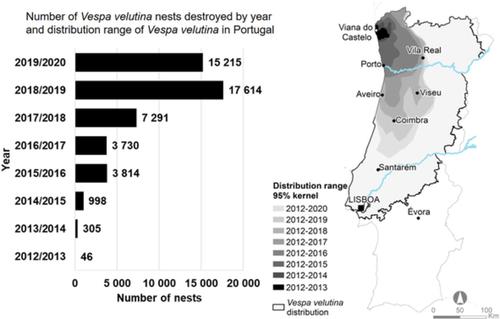当前位置:
X-MOL 学术
›
Insect Conserv. Divers.
›
论文详情
Our official English website, www.x-mol.net, welcomes your
feedback! (Note: you will need to create a separate account there.)
Patterns of Vespa velutina invasion in Portugal using crowdsourced data
Insect Conservation and Diversity ( IF 3.2 ) Pub Date : 2020-04-23 , DOI: 10.1111/icad.12418 JoÃo Carvalho 1 , Dário Hipólito 1 , Frederico Santarém 2, 3 , Raquel Martins 1 , Alberto Gomes 4 , Paulo Carmo 5 , Rogério Rodrigues 5 , José Grosso‐Silva 6 , Carlos Fonseca 1
中文翻译:

使用众包数据的葡萄牙Vespa velutina入侵模式
更新日期:2020-04-23
Insect Conservation and Diversity ( IF 3.2 ) Pub Date : 2020-04-23 , DOI: 10.1111/icad.12418 JoÃo Carvalho 1 , Dário Hipólito 1 , Frederico Santarém 2, 3 , Raquel Martins 1 , Alberto Gomes 4 , Paulo Carmo 5 , Rogério Rodrigues 5 , José Grosso‐Silva 6 , Carlos Fonseca 1
Affiliation

|
- The invasive yellow‐legged hornet (Vespa velutina) was first detected in mainland Portugal in September 2011. The lack of information regarding the processes of species spread has hampered the development of adequate measures to mitigate the potential impact of this invasive predator.
- Crowdsourced data, i.e., information opportunistically reported by citizens, can facilitate the collection of numerous species occurrence records over large spatial scales, which can be valuable to understand the expansion of invasive species. Here, using validated crowdsourced data on the precise location of 49 013 nests, we: (i) update information regarding V. velutina distribution in Portugal; (ii) estimate the species expansion rate; and (iii) analyse the patterns of nests distribution at national and local scales.
- The species is currently distributed over an area of approximately 57 000 km2, which corresponds to 62% of mainland Portugal. We estimated an average rate of 37.4 ± 13.2 km/year for V. velutina expansion. Vespa velutina nests presented an aggregated distribution and nest density at the urban local‐scale was estimated in 5.4 ± 3.3 nests/km2. The observed decrease in the nearest‐neighbour nest distance over the years suggests that the density of nests has not reached its limit.
- We advocate that the development of a cheap and rapid method for nest detection and the study of fine‐scale mechanisms leading to V. velutina dispersal are important steps to identify colonisation pathways and plan management approaches aiming to halt species spread and impact in apiaries.
中文翻译:

使用众包数据的葡萄牙Vespa velutina入侵模式
- 入侵性黄足大黄蜂(Vespa velutina)于2011年9月在葡萄牙大陆首次发现。缺乏有关物种传播过程的信息,阻碍了缓解该入侵性捕食者潜在影响的适当措施的开发。
- 众包数据,即公民机会性地报告的信息,可以促进在大空间范围内收集众多物种发生记录,这对于了解入侵物种的扩展可能是有价值的。在这里,使用关于49 013个巢的精确位置的经过验证的众包数据,我们:(i)更新有关V的信息。velutina在葡萄牙的分布;(ii)估计物种的扩张速度;(iii)分析国家和地方尺度上的巢穴分布模式。
- 该物种目前分布在大约57 000 km 2的面积上,占葡萄牙大陆的62%。我们估计V的平均速率为37.4±13.2 km /年。velutina扩张。Vespa velutina巢呈现聚集分布,在城市局部范围内的巢密度估计为5.4±3.3巢/ km 2。多年来观察到的最近邻巢距离的减少表明巢的密度尚未达到其极限。
- 我们主张开发一种便宜且快速的嵌套检测方法,并研究导致V的精细机制。velutina扩散是确定定居途径和计划管理方法的重要步骤,旨在制止物种在养蜂场中的传播和影响。











































 京公网安备 11010802027423号
京公网安备 11010802027423号